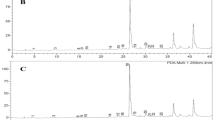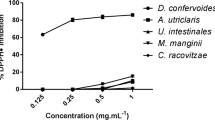Abstract
Asparagopsis taxiformis has potent antimethanogenic activity as a feed supplement at 2 % of organic matter in in vitro bioassays. This study identified the main bioactive natural products and their effects on fermentation using rumen fluid from Bos indicus steers. Polar through to non-polar extracts (water, methanol, dichloromethane and hexane) were tested. The dichloromethane extract was most active, reducing methane production by 79 %. Bromoform was the most abundant natural product in the biomass of Asparagopsis (1723 μg g−1 dry weight [DW] biomass), followed by dibromochloromethane (15.8 μg g−1 DW), bromochloroacetic acid (9.8 μg g−1 DW) and dibromoacetic acid (0.9 μg g−1 DW). Bromoform and dibromochloromethane had the highest activity with concentrations ≥1 μM inhibiting methane production. However, only bromoform was present in sufficient quantities in the biomass at 2 % organic matter to elicit this effect. Importantly, the degradability of organic matter and volatile fatty acids were not affected at effective concentrations.




Similar content being viewed by others
References
Abecia L, Toral PG, Martín-García AI, Martínez G, Tomkins NW, Molina-Alcaide E, Newbold CJ, Yáñez-Ruiz DR (2012) Effect of bromochloromethane on methane emission, rumen fermentation pattern, milk yield, and fatty acid profile in lactating dairy goats. J Dairy Sci 95:2027–2036
Anderson M, Gorley R, Clarke K (2008) PERMANOVA + for PRIMER: guide to software and statistical methods. PRIMER-E
Anderson RC, Huwe JK, Smith DJ, Stanton TB, Krueger NA, Callaway TR, Edrington TS, Harvey RB, Nisbet DJ (2010) Effect of nitroethane, dimethyl-2-nitroglutarate and 2-nitro-methyl-propionate on ruminal methane production and hydrogen balance in vitro. Bioresour Technol 101:5345–5349
Bueno I, Cabral Filho SL, Gobbo SP, Louvandini H, Vitti DM, Abdalla AL (2005) Influence of inoculum source in a gas production method. Anim Feed Sci Technol 123:95–105
Burreson B, Moore RE, Roller P (1975) Haloforms in the essential oil of the alga Asparagopsis taxiformis (Rhodophyta). Tetrahedron Lett 16:473–476
Chalupa W (1977) Manipulating rumen fermentation. J Anim Sci 45:585–599
DiMarco AA, Bobik TA, Wolfe RS (1990) Unusual coenzymes of methanogenesis. Annu Rev Biochem 59:355–394
Durmic Z, Moate PJ, Eckard R, Revell DK, Williams R, Vercoe PE (2014) In vitro screening of selected feed additives, plant essential oils and plant extracts for rumen methane mitigation. J Sci Food Agric 94:1191–1196
Goel G, Makkar HP, Becker K (2009) Inhibition of methanogens by bromochloromethane: effects on microbial communities and rumen fermentation using batch and continuous fermentations. Br J Nutr 101:1484–1492
Goering H, Van Soest PJ (1970) Forage fiber analyses (apparatus, reagents, procedures, and some applications). US Agricultural Research Service Washington, DC
Guiry M, Guiry G (2014) AlgaeBase. World-wide electronic publication. National University of Ireland, Galway. http://www.algaebase.org accessed 17 Nov 2014
Hristov A, Oh J, Meinen R, Montes F, Ott T, Firkins J, Rotz A, Dell C, Adesogan A, Yang W, Tricarico J, Kebreab E, Waghorn G, Dijkstra J, Oosting S (2013) Mitigation of greenhouse gas emissions in livestock production—a review of technical options for non-CO2 emissions. In: Gerber P, Henderson B, Makkar H (eds) FAO Animal Production and Health Paper No. 177. Rome, Italy, p 231
Lanigan G (1972) Metabolism of pyrrolizidine alkaloids in the ovine rumen. IV. Effects of chloral hydrate and halogenated methanes on rumen methanogenesis and alkaloid metabolism in fistulated sheep. Crop Pasture Sci 23:1085–1091
Liu H, Wang J, Wang A, Chen J (2011) Chemical inhibitors of methanogenesis and putative applications. Appl Microbiol Biotechnol 89:1333–1340
Machado L, Magnusson M, Paul NA, de Nys R, Tomkins N (2014) Effects of marine and freshwater macroalgae on in vitro total gas and methane production. PLoS ONE 9(1):e85289
Machado L, Magnusson M, Paul NA, Kinley R, de Nys R, Tomkins N (2015) Dose–response effects of Asparagopsis taxiformis and Oedogonium sp. on in vitro fermentation and methane production. J Appl Phycol: doi: 10.1007/s10811-015-0639-9
Martin C, Morgavi D, Doreau M (2010) Methane mitigation in ruminants: from microbe to the farm scale. Animal 4:351–365
Mata L, Gaspar H, Santos R (2012) Carbon/nutrient balance in relation to biomass production and halogenated compound content in the red alga Asparagopsis taxiformis (Bonnemaisoniaceae). J Phycol 48:248–253
McConnell O, Fenical W (1977) Halogen chemistry of the red alga Asparagopsis. Phytochemistry 16:367–374
Mitsumori M, Shinkai T, Takenaka A, Enishi O, Higuchi K, Kobayashi Y, Nonaka I, Asanuma N, Denman SE, McSweeney CS (2012) Responses in digestion, rumen fermentation and microbial populations to inhibition of methane formation by a halogenated methane analogue. Br J Nutr 108:482–491
Moore RE (1977) Volatile compounds from marine algae. Acc Chem Res 10:40–47
Morgavi D, Forano E, Martin C, Newbold CJ (2010) Microbial ecosystem and methanogenesis in ruminants. Animal 4:1024–1036
Nagadi S, Herrero M, Jessop NS (2000) The effect of fermentable nitrogen availability on in vitro gas production and degradability of NDF. Anim Feed Sci Technol 87:241–251
NHMRC (2004) Australian code of practice for the care and use of animals for scientific purposes. National Health and Medical Research Council, Camberra
Patra AK (2012) Enteric methane mitigation technologies for ruminant livestock: a synthesis of current research and future directions. Environ Monit Assess 184:1929–1952
Patra AK, Yu Z (2014) Combinations of nitrate, saponin, and sulphate additively reduce methane production by rumen cultures in vitro while not adversely affecting feed digestion, fermentation or microbial communities. Bioresour Technol 155:129–135
Paul N, de Nys R, Steinberg P (2006a) Chemical defence against bacteria in the red alga Asparagopsis armata: linking structure with function. Mar Ecol Prog Ser 306:87–101
Paul NA, De Nys R, Steinberg PD (2006b) Seaweed-herbivore interactions at a small scale: direct tests of feeding deterrence by filamentous algae. Mar Ecol Prog Ser 323:1–9
Salvador N, Gómez Garreta A, Lavelli L, Ribera MA (2007) Antimicrobial activity of Iberian macroalgae. Sci Mar 71:101–114
Satter L, Slyter L (1974) Effect of ammonia concentration on rumen microbial protein production in vitro. Br J Nutr 32:199–208
Tamminga S (1979) Protein degradation in the forestomachs of ruminants. J Anim Sci 49:1615–1630
Tomkins N, Colegate S, Hunter R (2009) A bromochloromethane formulation reduces enteric methanogenesis in cattle fed grain-based diets. Anim Prod Sci 49:1053–1058
Ungerfeld E, Kohn R (2006) The role of thermodynamics in the control of ruminal fermentation. In: Sejrsen K, Hvelplund T, Nielsen MO (eds) Ruminant physiology: digestion, metabolism and impact of nutrition on gene expression, immunology and stress. Wageningen Academic Publishers, Wageningen, The Netherlands, pp 55–85
Vergés A, Paul NA, Steinberg PD (2008) Sex and life-history stage alter herbivore responses to a chemically defended red alga. Ecology 89:1334–1343
Wang Y, Xu Z, Bach S, McAllister T (2008) Effects of phlorotannins from Ascophyllum nodosum (brown seaweed) on in vitro ruminal digestion of mixed forage or barley grain. Anim Feed Sci Technol 145:375–395
Wood J, Kennedy FS, Wolfe R (1968) Reaction of multihalogenated hydrocarbons with free and bound reduced vitamin B12. Biochemistry 7:1707–1713
Woolard FX, Moore RE, Roller PP (1979) Halogenated acetic and acrylic acids from the red alga Asparagopsis taxiformis. Phytochemistry 18:617–620
Yusuf RO, Noor ZZ, Abba AH, Hassan MAA, Din MFM (2012) Methane emission by sectors: a comprehensive review of emission sources and mitigation methods. Renew Sust Energy Rev 16:5059–5070
Acknowledgments
This research is supported by funding from the Australian Government Department of Agriculture, the Australian Government through the Australian Renewable Energy Agency, and the Advanced Manufacturing Cooperative Research Centre (AMCRC), funded through the Australian Government’s Cooperative Research Centre Scheme. We thank Dr. Mike Devery for kindly supplying the bromochloromethane used in this study. We also thank Pedro Henrique de Paula Silva for reviewing the manuscript.
Author information
Authors and Affiliations
Corresponding author
Ethics declarations
Rumen fluid was collected from four rumen-fistulated Brahman (B. indicus) steers, which were maintained according to guidelines approved by CSIRO Animal Ethics Committee (A5/2011) and in accordance with the Australian Code of Practice for the Care and Use of Animals for Scientific Purposes.
Electronic supplementary material
Below is the link to the electronic supplementary material.
Figure S1
Effects of Asparagopsis biomass and extracts (doses equivalent to Asparagopsis 2 % OM) on production of (A) total gas (TGP), and (B) CH4 over a 24 h fermentation period. Error bars represent ± SE (n = 3). DCM = dichloromethane. (GIF 73 kb)
Table S1
Results of full factorial permutational analyses of variance (PERMANOVAs) testing the effects of the fixed factors pure compound, and assay-concentration on total gas production (TGP), methane (CH4), and hydrogen (H2). Analyses were conducted in Primer v6 (Primer-E Ltd, UK) using Bray-Curtis dissimilarities on fourth root transformed data and 9999 unrestricted permutations of raw data. Pseudo F (F) and P values are presented (n = 3). (DOCX 14 kb)
Table S2
ANOVA results of the natural product yields of each solvent extract of Asparagopsis biomass [μg g-1 dry weight (DW)], (Experiment 2). (DOCX 14 kb)
Table S3
Results of full factorial permutational analyses of variance (PERMANOVAs) testing the effects of the fixed factors pure compound, and assay-concentration on total gas production (TGP), methane (CH4), and hydrogen (H2). Analyses were conducted in Primer v6 (Primer-E Ltd, UK) using Bray-Curtis dissimilarities on fourth root transformed data and 9999 unrestricted permutations of raw data. Pseudo F (F) and P values are presented (n = 3). (DOCX 14 kb)
Table S4
Results of full factorial permutational analyses of variance (PERMANOVAs) testing the effects of the fixed factors pure compound and assay-concentration on total gas production (TGP), methane (CH4), and hydrogen (H2), (Experiment 3). Analyses were conducted in Primer v6 (Primer-E Ltd, UK) using Bray-Curtis dissimilarities on fourth root transformed data and 9999 unrestricted permutations of raw data (n = 4). (DOCX 18 kb)
Rights and permissions
About this article
Cite this article
Machado, L., Magnusson, M., Paul, N.A. et al. Identification of bioactives from the red seaweed Asparagopsis taxiformis that promote antimethanogenic activity in vitro. J Appl Phycol 28, 3117–3126 (2016). https://doi.org/10.1007/s10811-016-0830-7
Received:
Revised:
Accepted:
Published:
Issue Date:
DOI: https://doi.org/10.1007/s10811-016-0830-7




